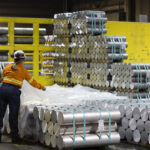This central Oklahoma town of 2,400 claims two things as its own: Olympian Jim Thorpe and an annual kolache festival that honors its Czech heritage every May. Some locals here say the place should be known for a third: earthquakes.
“There’s been more than 10 or so,” since a magnitude 5.6 quake hit west of town in November 2011, damaging buildings and rattling nerves, said longtime resident Mark Treat, 54, sounding downright blase about them all. “I’m pretty sure we had one or two last year.”
Quakes with 3.4, 3.3, 3.1, 2.9 and 2.3 magnitudes have all rumbled near this town about 60 miles east of Oklahoma City in the past two years, and a new report by the U.S. Geological Survey suggests a quake “swarm” continues to plague central Oklahoma, which is far more accustomed to dealing with natural disasters that come from above than below.
Since January 2009, more than 200 magnitude 3.0 or greater earthquakes have hit central Oklahoma – marking a significant rise in the frequency of the seismic events, the survey reports. The study released Tuesday shows that one to three magnitude 3.0 earthquakes or larger occurred yearly in Oklahoma from 1975 to 2008, but the average grew to around 40 earthquakes per year from 2009-2013.
The swarm includes the 2011 quake, the largest ever recorded in Oklahoma, which damaged 200 buildings, shook a football stadium and could be felt throughout the state and in Arkansas, Kansas, Missouri, northern Texas and some parts of Illinois and Wisconsin. Until then, the biggest earthquake in the state had been a 5.5 magnitude temblor that jolted the city of El Reno, located just west of Oklahoma City, in 1952.
“When I came to Oklahoma, I would do public outreach, saying that Oklahoma does have an earthquake hazard, and I got the blank stares and they didn’t almost quite believe it,” remembered Austin Holland, seismologist with the Oklahoma Geological Survey, which co-issued the report. “A good takeaway from this is that still, the chances of a damaging tornado or damaging ice storm are greater than a damaging earthquake, but people need to be prepared for any hazard we face in Oklahoma.
“Certainly, (earthquakes) will be a part of life for a while, and people need to be aware of that,” Holland said.
Scientists continue to study why the earthquake rate has changed so dramatically throughout this swath of Oklahoma – including possible links to wastewater disposal related to oil and gas production in the region.
Some researchers and environmental groups have long held that hydraulic fracturing, or “fracking,” – a process employed by energy companies that involves forcing millions of gallons of water, sand and other additives deep into the ground to free up pockets of natural gas – is a chief culprit for the rise in earthquake activity throughout Oklahoma and other states.
“It’s important to understand that it’s not the fracking process that causes these earthquakes,” said Bill Leith, the earthquake hazards program coordinator with the U.S. Geological Survey in Reston, Va., who labels the quake swarm affecting central Oklahoma as “unusual.” “During the production from oil and gas activities, there’s a lot of wastewater that’s generated, and it is that reinjection into rock formations” that could trigger some quakes.
The energy industry has repeatedly denied that the method is to blame for the increase in seismic activity.
“The link between hydraulic fracturing and earthquakes has been exaggerated and distorted by dramatic media headlines,” said Julia Bell, a spokeswoman for the Independent Petroleum Association of America, a Washington-based group that represents thousands of oil and natural gas producers. “Experts have repeatedly asserted that the energy released from hydraulic fracturing is equivalent to a gallon of milk hitting the floor from a kitchen counter.”
Some residents in Prague, like Joe and Mary Reneau, whose two-story brick home was heavily damaged after the 2011 quake, don’t appear to be too alarmed about the USGS findings, even though some of her more paranoid neighbors now phone the couple up every time their ground or house sways after a minor quake.
“What is it Mother always said? `Don’t go borrowing trouble,”‘ 70-year-old Mary Reneau said. “In other words, don’t go worrying about something that may not even happen.”
The Reneaus, who had earthquake insurance, rebuilt their house nearly from the studs up, to the tune of the $209,000 their policy paid out. But even with the 33 steel piers now reinforcing their home, the earthquakes that have struck since have triggered hairline cracks in the concrete driveway and some of the brickwork on the back patio and have ever-so-slightly pulled the kitchen cabinets away from the ceiling.
But such damages are just a part of life around here.
“You can’t get excited every time the ground shakes,” she said.
Treat, who also lives in the pocket of town that took the brunt of the damage from the 2011 quake, shrugs at news that more quakes could be in the town’s future, even though when they hit the vibrations shake the dishes, TV and the bed and make his floor “feel like an ocean.”
“It ain’t going to change nothing, we got to live with what we got to live with,” he said. “It’s like tornadoes – you can’t live your life scared of them, either.”
Was this article valuable?
Here are more articles you may enjoy.

 J&J Spars With Foes of $9 Billion Talc Cancer Plan as Trial Ends
J&J Spars With Foes of $9 Billion Talc Cancer Plan as Trial Ends  Verisk Webinar Highlights Emerging Psychoactive Substance Risks
Verisk Webinar Highlights Emerging Psychoactive Substance Risks  Musk Blames X Outage on Cyberattack
Musk Blames X Outage on Cyberattack  Trump Says He’s Doubling Tariffs on Canadian Steel, Aluminum
Trump Says He’s Doubling Tariffs on Canadian Steel, Aluminum 